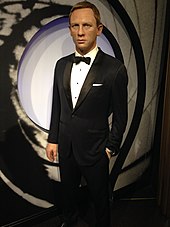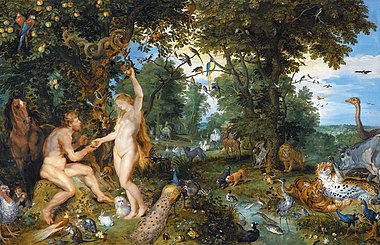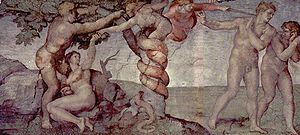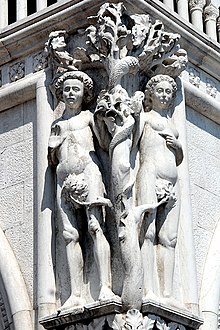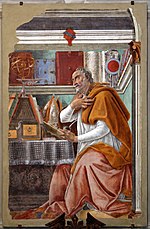| James Bond | |
|---|---|
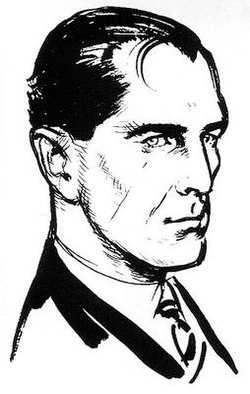 Ian Fleming's image of James Bond; commissioned to aid the Daily Express comic strip artists | |
| Created by | Ian Fleming |
| Original work | Casino Royale (1953) |
| Print publications | |
| Novel(s) | List of novels |
| Short stories | See list of novels |
| Comics | List of comic books |
| Comic strip(s) | James Bond (1958–1983) |
| Films and television | |
| Film(s) | List of films |
| Short film(s) | Happy and Glorious (2012) |
| Television series | "Casino Royale" (Climax! season 1 - episode 3) (1954) |
| Animated series | James Bond Jr. (1991–1992) |
| Games | |
| Traditional | Various |
| Role-playing | James Bond 007: Role-Playing In Her Majesty's Secret Service |
| Video game(s) | List of video games |
| Audio | |
| Radio program(s) | Radio dramas |
| Original music | Music |
| Miscellaneous | |
| Toy(s) | Various |
| Portrayers | |
The James Bond series focuses on a fictional British Secret Service agent created in 1953 by writer Ian Fleming, who featured him in twelve novels and two short-story collections. Since Fleming's death in 1964, eight other authors have written authorised Bond novels or novelisations: Kingsley Amis, Christopher Wood, John Gardner, Raymond Benson, Sebastian Faulks, Jeffery Deaver, William Boyd, and Anthony Horowitz. The latest novel is Forever and a Day by Anthony Horowitz, published in May 2018. Additionally Charlie Higson wrote a series on a young James Bond, and Kate Westbrook wrote three novels based on the diaries of a recurring series character, Moneypenny.
The character—also known by the code number 007 (pronounced "double-O-seven")—has also been adapted for television, radio, comic strip, video games and film. The films are one of the longest continually running film series and have grossed over US$7.04 billion in total, making it the fifth-highest-grossing film series to date, which started in 1962 with Dr. No, starring Sean Connery as Bond. As of 2022, there have been twenty-five films in the Eon Productions series. The most recent Bond film, No Time to Die (2021), stars Daniel Craig in his fifth portrayal of Bond; he is the sixth actor to play Bond in the Eon series. There have also been two independent productions of Bond films: Casino Royale (a 1967 spoof starring David Niven) and Never Say Never Again (a 1983 remake of an earlier Eon-produced film, 1965's Thunderball, both starring Connery). In 2015 the series was estimated to be worth $19.9 billion, making James Bond one of the highest-grossing media franchises of all time.
The Bond films are renowned for a number of features, including the musical accompaniment, with the theme songs having received Academy Award nominations on several occasions, and two wins. Other important elements which run through most of the films include Bond's cars, his guns, and the gadgets with which he is supplied by Q Branch. The films are also noted for Bond's relationships with various women, who are popularly referred to as "Bond girls".
Publication history
Creation and inspiration
Ian Fleming created the fictional character of James Bond as the central figure for his works. Bond is an intelligence officer in the Secret Intelligence Service, commonly known as MI6. Bond is known by his code number, 007, and was a Royal Naval Reserve Commander. Fleming based his fictional creation on a number of individuals he came across during his time in the Naval Intelligence Division and 30 Assault Unit during the Second World War, admitting that Bond "was a compound of all the secret agents and commando types I met during the war". Among those types were his brother, Peter, who had been involved in behind-the-lines operations in Norway and Greece during the war. Aside from Fleming's brother, a number of others also provided some aspects of Bond's make up, including Conrad O'Brien-ffrench, Patrick Dalzel-Job and Bill "Biffy" Dunderdale.
The name James Bond came from that of the American ornithologist James Bond, a Caribbean bird expert and author of the definitive field guide Birds of the West Indies. Fleming, a keen birdwatcher himself, had a copy of Bond's guide and he later explained to the ornithologist's wife that "It struck me that this brief, unromantic, Anglo-Saxon and yet very masculine name was just what I needed, and so a second James Bond was born". He further explained that:
When I wrote the first one in 1953, I wanted Bond to be an extremely dull, uninteresting man to whom things happened; I wanted him to be a blunt instrument ... when I was casting around for a name for my protagonist I thought by God, [James Bond] is the dullest name I ever heard.
— Ian Fleming, The New Yorker, 21 April 1962
On another occasion, Fleming said: "I wanted the simplest, dullest, plainest-sounding name I could find, 'James Bond' was much better than something more interesting, like 'Peregrine Carruthers'. Exotic things would happen to and around him, but he would be a neutral figure—an anonymous, blunt instrument wielded by a government department."
Fleming decided that Bond should resemble both American singer Hoagy Carmichael and himself and in Casino Royale, Vesper Lynd remarks, "Bond reminds me rather of Hoagy Carmichael, but there is something cold and ruthless." Likewise, in Moonraker, Special Branch officer Gala Brand thinks that Bond is "certainly good-looking ... Rather like Hoagy Carmichael in a way. That black hair falling down over the right eyebrow. Much the same bones. But there was something a bit cruel in the mouth, and the eyes were cold."
Fleming endowed Bond with many of his own traits, including sharing the same golf handicap, the taste for scrambled eggs, and using the same brand of toiletries. Bond's tastes are also often taken from Fleming's own as was his behaviour, with Bond's love of golf and gambling mirroring Fleming's own. Fleming used his experiences of his espionage career and all other aspects of his life as inspiration when writing, including using names of school friends, acquaintances, relatives and lovers throughout his books.
It was not until the penultimate novel, You Only Live Twice, that Fleming gave Bond a sense of family background. The book was the first to be written after the release of Dr. No in cinemas, and Sean Connery's depiction of Bond affected Fleming's interpretation of the character, henceforth giving Bond both a dry sense of humour and Scottish antecedents that were not present in the previous stories. In a fictional obituary, purportedly published in The Times, Bond's parents were given as Andrew Bond, from the village of Glencoe, Scotland, and Monique Delacroix, from the canton of Vaud, Switzerland. Fleming did not provide Bond's date of birth, but John Pearson's fictional biography of Bond, James Bond: The Authorized Biography of 007, gives Bond a birth date on 11 November 1920, while a study by John Griswold puts the date at 11 November 1921.
Ian Fleming novels
Whilst serving in the Naval Intelligence Division, Fleming had planned to become an author and had told a friend, "I am going to write the spy story to end all spy stories." On 17 February 1952, he began writing his first James Bond novel, Casino Royale, at his Goldeneye estate in Jamaica, where he wrote all his Bond novels during the months of January and February each year. He started the story shortly before his wedding to his pregnant girlfriend, Ann Charteris, in order to distract himself from his forthcoming nuptials.
After completing the manuscript for Casino Royale, Fleming showed it to his friend (and later editor) William Plomer to read. Plomer liked it and submitted it to the publishers, Jonathan Cape, who did not like it as much. Cape finally published it in 1953 on the recommendation of Fleming's older brother Peter, an established travel writer. Between 1953 and 1966, two years after his death, twelve novels and two short-story collections were published, with the last two books—The Man with the Golden Gun and Octopussy and The Living Daylights—published posthumously. All the books were published in the UK through Jonathan Cape.
|
|
Post-Fleming novels
After Fleming's death, a continuation novel, Colonel Sun, was written by Kingsley Amis (as Robert Markham) and published in 1968. Amis had already written a literary study of Fleming's Bond novels in his 1965 work The James Bond Dossier. Although novelisations of two of the Eon Productions Bond films appeared in print, James Bond, The Spy Who Loved Me and James Bond and Moonraker, both written by screenwriter Christopher Wood, the series of novels did not continue until the 1980s. In 1981 the thriller writer John Gardner picked up the series with Licence Renewed. Gardner went on to write sixteen Bond books in total; two of the books he wrote—Licence to Kill and GoldenEye—were novelisations of Eon Productions films of the same name. Gardner moved the Bond series into the 1980s, although he retained the ages of the characters as they were when Fleming had left them. In 1996 Gardner retired from writing James Bond books due to ill health.
|
|
In 1996 the American author Raymond Benson became the author of the Bond novels. Benson had previously been the author of The James Bond Bedside Companion, first published in 1984. By the time he moved on to other, non-Bond related projects in 2002, Benson had written six Bond novels, three novelisations and three short stories.
|
|
After a gap of six years, Sebastian Faulks was commissioned by Ian Fleming Publications to write a new Bond novel, which was released on 28 May 2008, the 100th anniversary of Fleming's birth. The book—titled Devil May Care—was published in the UK by Penguin Books and by Doubleday in the US. American writer Jeffery Deaver was then commissioned by Ian Fleming Publications to produce Carte Blanche, which was published on 26 May 2011. The book turned Bond into a post-9/11 agent, independent of MI5 or MI6. On 26 September 2013, Solo by William Boyd, set in 1969, was published. In October 2014, it was announced that Anthony Horowitz was to write a Bond continuation novel. Set in the 1950s two weeks after the events of Goldfinger, it contains material written, but previously unreleased, by Fleming. Trigger Mortis was released on 8 September 2015. Horowitz's second Bond novel, Forever and a Day, tells the origin story of Bond as a 00 agent prior to the events of Casino Royale. The novel, also based on unpublished material from Fleming, was released on 31 May 2018. Horowitz's third Bond novel, With a Mind to Kill, will be published on 26 May 2022.
|
|
Young Bond
The Young Bond series of novels was started by Charlie Higson and, between 2005 and 2009, five novels and one short story were published. The first Young Bond novel, SilverFin was also adapted and released as a graphic novel on 2 October 2008 by Puffin Books. In October 2013 Ian Fleming Publications announced that Stephen Cole would continue the series, with the first edition scheduled to be released in Autumn 2014.
|
The Moneypenny Diaries
The Moneypenny Diaries are a trilogy of novels chronicling the life of Miss Moneypenny, M's personal secretary. The novels are written by Samantha Weinberg under the pseudonym Kate Westbrook, who is depicted as the book's "editor". The first instalment of the trilogy, subtitled Guardian Angel, was released on 10 October 2005 in the UK. A second volume, subtitled Secret Servant was released on 2 November 2006 in the UK, published by John Murray. A third volume, subtitled Final Fling was released on 1 May 2008.
Adaptations
Television
In 1954 CBS paid Ian Fleming $1,000 ($9,637 in 2020 dollars) to adapt his novel Casino Royale into a one-hour television adventure, "Casino Royale", as part of its Climax! series. The episode aired live on 21 October 1954 and starred Barry Nelson as "Card Sense" James Bond and Peter Lorre as Le Chiffre. The novel was adapted for American audiences to show Bond as an American agent working for "Combined Intelligence", while the character Felix Leiter—American in the novel—became British onscreen and was renamed "Clarence Leiter".
In 1973 a BBC documentary Omnibus: The British Hero featured Christopher Cazenove playing a number of such title characters (e.g. Richard Hannay and Bulldog Drummond). The documentary included James Bond in dramatised scenes from Goldfinger—notably featuring 007 being threatened with the novel's circular saw, rather than the film's laser beam—and Diamonds Are Forever. In 1991 a kids's spin-off TV cartoon series, James Bond Jr., was produced with Corey Burton in the role of Bond's nephew, also called James Bond.
Radio
In 1958, the novel Moonraker was adapted for broadcast on South African radio, with Bob Holness providing the voice of Bond. According to The Independent, "listeners across the Union thrilled to Bob's cultured tones as he defeated evil master criminals in search of world domination".
The BBC have adapted five of the Fleming novels for broadcast: in 1990 You Only Live Twice was adapted into a 90-minute radio play for BBC Radio 4 with Michael Jayston playing James Bond. The production was repeated a number of times between 2008 and 2011. On 24 May 2008 BBC Radio 4 broadcast an adaptation of Dr. No. The actor Toby Stephens, who played Bond villain Gustav Graves in the Eon Productions version of Die Another Day, played Bond, while Dr. No was played by David Suchet. Following its success, a second story was adapted and on 3 April 2010 BBC Radio 4 broadcast Goldfinger with Stephens again playing Bond. Sir Ian McKellen was Goldfinger and Stephens' Die Another Day co-star Rosamund Pike played Pussy Galore. The play was adapted from Fleming's novel by Archie Scottney and was directed by Martin Jarvis. In 2012 the novel From Russia, with Love was dramatised for Radio 4; it featured a full cast again starring Stephens as Bond. In May 2014 Stephens again played Bond, in On Her Majesty's Secret Service, with Alfred Molina as Blofeld, and Joanna Lumley as Irma Bunt.
Comics
In 1957 the Daily Express approached Ian Fleming to adapt his stories into comic strips, offering him £1,500 per novel and a share of takings from syndication. After initial reluctance, Fleming, who felt the strips would lack the quality of his writing, agreed. To aid the Daily Express in illustrating Bond, Fleming commissioned an artist to create a sketch of how he believed James Bond looked. The illustrator, John McLusky, however, felt that Fleming's 007 looked too "outdated" and "pre-war" and changed Bond to give him a more masculine look. The first strip, Casino Royale was published from 7 July 1958 to 13 December 1958 and was written by Anthony Hern and illustrated by John McLusky.
Most of the Bond novels and short stories have since been adapted for illustration, as well as Kingsley Amis's Colonel Sun; the works were written by Henry Gammidge or Jim Lawrence with Yaroslav Horak replacing McClusky as artist in 1966. After the Fleming and Amis material had been adapted, original stories were produced, continuing in the Daily Express and Sunday Express until May 1977.
Several comic book adaptations of the James Bond films have been published through the years: at the time of Dr. No's release in October 1962, a comic book adaptation of the screenplay, written by Norman J. Nodel, was published in Britain as part of the Classics Illustrated anthology series. It was later reprinted in the United States by DC Comics as part of its Showcase anthology series, in January 1963. This was the first American comic book appearance of James Bond and is noteworthy for being a relatively rare example of a British comic being reprinted in a fairly high-profile American comic. It was also one of the earliest comics to be censored on racial grounds (some skin tones and dialogue were changed for the American market).
With the release of the 1981 film For Your Eyes Only, Marvel Comics published a two-issue comic book adaptation of the film. When Octopussy was released in the cinemas in 1983, Marvel published an accompanying comic; Eclipse also produced a one-off comic for Licence to Kill, although Timothy Dalton refused to allow his likeness to be used. New Bond stories were also drawn up and published from 1989 onwards through Marvel, Eclipse Comics, Dark Horse Comics and Dynamite Entertainment.
Films
Eon Productions films
Eon Productions, the company of Canadian Harry Saltzman and American Albert R. "Cubby" Broccoli, released the first cinema adaptation of an Ian Fleming novel, Dr. No (1962), based on the eponymous 1958 novel and featuring Sean Connery as 007. Connery starred in a further four films before leaving the role after You Only Live Twice (1967), which was taken up by George Lazenby for On Her Majesty's Secret Service (1969). Lazenby left the role after just one appearance and Connery was brought back for his last Eon-produced film Diamonds Are Forever.
Roger Moore was appointed to the role of 007 for Live and Let Die (1973). He played Bond a further six times over twelve years, before being replaced by Timothy Dalton for two films. After a six-year hiatus, during which a legal wrangle threatened Eon's productions of the Bond films, Irish actor Pierce Brosnan was cast as Bond in GoldenEye (1995); he remained in the role for a total of four films through 2002. In 2006, Daniel Craig was given the role for Casino Royale (2006), which rebooted the series. Craig appeared for a total of five films. The series has grossed well over $7 billion to date, making it the fifth-highest-grossing film series.
- Sean Connery
(1962–67; 1971) - George Lazenby
(1969) - Roger Moore
(1973–85) - Timothy Dalton
(1987–89) - Pierce Brosnan
(1995–2002) - Daniel Craig
(2006–21)
| Title | Year | Actor | Director |
|---|---|---|---|
| Dr. No | 1962 | Sean Connery | Terence Young |
| From Russia with Love | 1963 | ||
| Goldfinger | 1964 | Guy Hamilton | |
| Thunderball | 1965 | Terence Young | |
| You Only Live Twice | 1967 | Lewis Gilbert | |
| On Her Majesty's Secret Service | 1969 | George Lazenby | Peter R. Hunt |
| Diamonds Are Forever | 1971 | Sean Connery | Guy Hamilton |
| Live and Let Die | 1973 | Roger Moore | |
| The Man with the Golden Gun | 1974 | ||
| The Spy Who Loved Me | 1977 | Lewis Gilbert | |
| Moonraker | 1979 | ||
| For Your Eyes Only | 1981 | John Glen | |
| Octopussy | 1983 | ||
| A View to a Kill | 1985 | ||
| The Living Daylights | 1987 | Timothy Dalton | |
| Licence to Kill | 1989 | ||
| GoldenEye | 1995 | Pierce Brosnan | Martin Campbell |
| Tomorrow Never Dies | 1997 | Roger Spottiswoode | |
| The World Is Not Enough | 1999 | Michael Apted | |
| Die Another Day | 2002 | Lee Tamahori | |
| Casino Royale | 2006 | Daniel Craig | Martin Campbell |
| Quantum of Solace | 2008 | Marc Forster | |
| Skyfall | 2012 | Sam Mendes | |
| Spectre | 2015 | ||
| No Time to Die | 2021 | Cary Joji Fukunaga[129] |
Non-Eon films
In 1967 Casino Royale was adapted into a parody Bond film starring David Niven as Sir James Bond and Ursula Andress as Vesper Lynd. Niven had been Fleming's preference for the role of Bond. The result of a court case in the High Court in London in 1963 allowed Kevin McClory to produce a remake of Thunderball titled Never Say Never Again in 1983. The film, produced by Jack Schwartzman's Taliafilm production company and starring Sean Connery as Bond, was not part of the Eon series of Bond films. In 1997 the Sony Corporation acquired all or some of McClory's rights in an undisclosed deal, which were then subsequently acquired by MGM, whilst on 4 December 1997, MGM announced that the company had purchased the rights to Never Say Never Again from Taliafilm. As of 2015, Eon holds the full adaptation rights to all of Fleming's Bond novels.
| Title | Year | Actor | Director(s) |
|---|---|---|---|
| Casino Royale | 1967 | David Niven | Ken Hughes John Huston Joseph McGrath Robert Parrish Val Guest Richard Talmadge |
| Never Say Never Again | 1983 | Sean Connery | Irvin Kershner |
Music
" cocky, swaggering, confident, dark, dangerous, suggestive, sexy, unstoppable."
The "James Bond Theme" was written by Monty Norman and was first orchestrated by the John Barry Orchestra for 1962's Dr. No, although the actual authorship of the music has been a matter of controversy for many years. In 2001, Norman won £30,000 in libel damages from The Sunday Times newspaper, which suggested that Barry was entirely responsible for the composition. The theme, as written by Norman and arranged by Barry, was described by another Bond film composer, David Arnold, as "bebop-swing vibe coupled with that vicious, dark, distorted electric guitar, definitely an instrument of rock 'n' roll ... it represented everything about the character you would want: It was cocky, swaggering, confident, dark, dangerous, suggestive, sexy, unstoppable. And he did it in two minutes." Barry composed the scores for eleven Bond films and had an uncredited contribution to Dr. No with his arrangement of the Bond Theme.
A Bond film staple are the theme songs heard during their title sequences sung by well-known popular singers. Several of the songs produced for the films have been nominated for Academy Awards for Original Song, including Paul McCartney's "Live and Let Die", Carly Simon's "Nobody Does It Better", Sheena Easton's "For Your Eyes Only", Adele's "Skyfall", and Sam Smith's "Writing's on the Wall". Adele won the award at the 85th Academy Awards, and Smith won at the 88th Academy Awards. For the non-Eon produced Casino Royale, Burt Bacharach's score included "The Look of Love" (sung by Dusty Springfield), which was nominated for an Academy Award for Best Original Song.
Video games
In 1983 the first Bond video game, developed and published by Parker Brothers, was released for the Atari 2600, Atari 5200, Atari 800, Commodore 64, and ColecoVision. Since then, there have been numerous video games either based on the films or using original storylines. In 1997 the first-person shooter video game GoldenEye 007 was developed by Rare for the Nintendo 64, based on GoldenEye. The game received highly positive reviews, won the BAFTA Interactive Entertainment Award for UK Developer of the Year in 1998, and sold over eight million copies worldwide, grossing $250 million, making it the third-best-selling Nintendo 64 game. It is frequently cited as one of the greatest video games of all time.
In 1999 Electronic Arts acquired the licence and released Tomorrow Never Dies on 16 December 1999. In October 2000, they released The World Is Not Enough for the Nintendo 64 followed by 007 Racing for the PlayStation on 21 November 2000. In 2003, the company released James Bond 007: Everything or Nothing, which included the likenesses and voices of Pierce Brosnan, Willem Dafoe, Heidi Klum, Judi Dench and John Cleese, amongst others. In November 2005, Electronic Arts released a video game adaptation of 007: From Russia with Love, which involved Sean Connery's image and voice-over for Bond. In 2006 Electronic Arts announced a game based on then-upcoming film Casino Royale: the game was cancelled because it would not be ready by the film's release in November of that year. With MGM losing revenue from lost licensing fees, the franchise was removed from EA to Activision. Activision subsequently released the 007: Quantum of Solace game on 31 October 2008, based on the film of the same name.
A new version of GoldenEye 007 featuring Daniel Craig was released for the Wii and a handheld version for the Nintendo DS in November 2010. A year later a new version was released for Xbox 360 and PlayStation 3 under the title GoldenEye 007: Reloaded. In October 2012 007 Legends was released, which featured one mission from each of the Bond actors of the Eon Productions' series. In November 2020, IO Interactive announced Project 007, an original James Bond video game, working closely with licensors MGM and Eon Productions.
Role-playing game
From 1983 to 1987, a licensed tabletop role-playing game, James Bond 007: Role-Playing In Her Majesty's Secret Service, was published by Victory Games (a branch of Avalon Hill) with it being designed by Gerard Christopher Klug. It was the most popular espionage role-playing game for its time. In addition to providing materials for players to create original scenarios, the game also offered players the opportunity to have adventures modelled after many of the Eon Productions film adaptations, albeit with modifications to provide challenges by preventing players from slavishly imitating Bond's actions in the stories.
Guns, vehicles and gadgets
Guns
For the first five novels, Fleming armed Bond with a Beretta 418 until he received a letter from a thirty-one-year-old Bond enthusiast and gun expert, Geoffrey Boothroyd, criticising Fleming's choice of firearm for Bond, calling it "a lady's gun—and not a very nice lady at that!" Boothroyd suggested that Bond should swap his Beretta for a 7.65mm Walther PPK and this exchange of arms made it to Dr. No. Boothroyd also gave Fleming advice on the Berns-Martin triple draw shoulder holster and a number of the weapons used by SMERSH and other villains. In thanks, Fleming gave the MI6 Armourer in his novels the name Major Boothroyd and, in Dr. No, M introduces him to Bond as "the greatest small-arms expert in the world". Bond also used a variety of rifles, including the Savage Model 99 in "For Your Eyes Only" and a Winchester .308 target rifle in "The Living Daylights". Other handguns used by Bond in the Fleming books included the Colt Detective Special and a long-barrelled Colt .45 Army Special.
The first Bond film, Dr. No, saw M ordering Bond to leave his Beretta behind and take up the Walther PPK, which Bond used in eighteen films. In Tomorrow Never Dies and the two subsequent films, Bond's main weapon was the Walther P99 semi-automatic pistol.
Vehicles
In the early Bond stories Fleming gave Bond a battleship-grey Bentley 4+1⁄2 Litre with an Amherst Villiers supercharger. After Bond's car was written off by Hugo Drax in Moonraker, Fleming gave Bond a Mark II Continental Bentley, which he used in the remaining books of the series. During Goldfinger, Bond was issued with an Aston Martin DB Mark III with a homing device, which he used to track Goldfinger across France. Bond returned to his Bentley for the subsequent novels.
The Bond of the films has driven a number of cars, including the Aston Martin V8 Vantage, during the 1980s, the V12 Vanquish and DBS during the 2000s, as well as the Lotus Esprit; the BMW Z3, BMW 750iL and the BMW Z8. He has, however, also needed to drive a number of other vehicles, ranging from a Citroën 2CV to a Routemaster Bus, amongst others.
Bond's most famous car is the silver grey Aston Martin DB5, first seen in Goldfinger; it later featured in Thunderball, GoldenEye, Tomorrow Never Dies, Casino Royale, Skyfall and Spectre. The films have used a number of different Aston Martins for filming and publicity, one of which was sold in January 2006 at an auction in the US for $2.1 million to an unnamed European collector. In 2010, another DB5 used in Goldfinger was sold at auction for $4.6m million (£2.6 million).
Gadgets
Fleming's novels and early screen adaptations presented minimal equipment such as the booby-trapped attaché case in From Russia, with Love, although this situation changed dramatically with the films. However, the effects of the two Eon-produced Bond films Dr. No and From Russia with Love had an effect on the novel The Man with the Golden Gun, through the increased number of devices used in Fleming's final story.
For the film adaptations of Bond, the pre-mission briefing by Q Branch became one of the motifs that ran through the series. Dr. No provided no spy-related gadgets, but a Geiger counter was used; industrial designer Andy Davey observed that the first ever onscreen spy-gadget was the attaché case shown in From Russia with Love, which he described as "a classic 007 product". The gadgets assumed a higher profile in the 1964 film Goldfinger. The film's success encouraged further espionage equipment from Q Branch to be supplied to Bond, although the increased use of technology led to an accusation that Bond was over-reliant on equipment, particularly in the later films.
"If it hadn't been for Q Branch, you'd have been dead long ago!"
—Q, to Bond, Licence to Kill
Davey noted that "Bond's gizmos follow the zeitgeist more closely than any other ... nuance in the films" as they moved from the potential representations of the future in the early films, through to the brand-name obsessions of the later films. It is also noticeable that, although Bond uses a number of pieces of equipment from Q Branch, including the Little Nellie autogyro, a jet pack and the exploding attaché case, the villains are also well-equipped with custom-made devices, including Scaramanga's golden gun, Rosa Klebb's poison-tipped shoes, Oddjob's steel-rimmed bowler hat and Blofeld's communication devices in his agents' vanity case.
Cultural impact
Cinematically, Bond has been a major influence within the spy genre since the release of Dr. No in 1962, with 22 secret agent films released in 1966 alone attempting to capitalise on the Bond franchise's popularity and success. The first parody was the 1964 film Carry On Spying, which shows the villain Dr. Crow being overcome by agents who included James Bind (Charles Hawtry) and Daphne Honeybutt (Barbara Windsor). One of the films that reacted against the portrayal of Bond was the Harry Palmer series, whose first film, The Ipcress File was released in 1965. The eponymous hero of the series was what academic Jeremy Packer called an "anti-Bond", or what Christoph Lindner calls "the thinking man's Bond". The Palmer series were produced by Harry Saltzman, who also used key crew members from the Bond series, including designer Ken Adam, editor Peter R. Hunt and composer John Barry. The four "Matt Helm" films starring Dean Martin (released between 1966 and 1969), the "Flint" series starring James Coburn (comprising two films, one each in 1966 and 1969), while The Man from U.N.C.L.E. also moved onto the cinema screen, with eight films released: all were testaments to Bond's prominence in popular culture. More recently, the Austin Powers series by writer, producer and comedian Mike Myers, and other parodies such as the Johnny English trilogy of films, have also used elements from or parodied the Bond films.
Following the release of the film Dr. No in 1962, the line "Bond ... James Bond", became a catch phrase that entered the lexicon of Western popular culture: writers Cork and Scivally said of the introduction in Dr. No that the "signature introduction would become the most famous and loved film line ever". In 2001, it was voted as the "best-loved one-liner in cinema" by British cinema goers, and in 2005, it was honoured as the 22nd greatest quotation in cinema history by the American Film Institute as part of their 100 Years Series. The 2005 American Film Institute's '100 Years' series recognised the character of James Bond himself as the third greatest film hero. He was also placed at number 11 on a similar list by Empire and as the fifth greatest movie character of all time by Premiere.
The 24 James Bond films produced by Eon are the longest continually running film series of all time, and including the two non Eon produced films, the 26 Bond films have grossed over $7.04 billion in total, making it the sixth-highest-grossing franchise to date. It is estimated that since Dr. No, a quarter of the world's population have seen at least one Bond film. The UK Film Distributors' Association have stated that the importance of the Bond series of films to the British film industry cannot be overstated, as they "form the backbone of the industry".
Television also saw the effect of Bond films, with the NBC series The Man from U.N.C.L.E., which was described as the "first network television imitation" of Bond, largely because Fleming provided advice and ideas on the development of the series, even giving the main character the name Napoleon Solo. Other 1960s television series inspired by Bond include I Spy, and Get Smart.
Considered a British cultural icon, James Bond had become such a symbol of the United Kingdom that the character, played by Craig, appeared in the opening ceremony of the 2012 London Olympics as Queen Elizabeth II's escort. From 1968 to 2003, and since 2016, the Cadbury chocolate box Milk Tray has been advertised by the 'Milk Tray Man', a tough James Bond–style figure who undertakes daunting 'raids' to surreptitiously deliver a box of Milk Tray chocolates to a lady.
Throughout the life of the film series, a number of tie-in products have been released. In 2018 a James Bond museum opened atop the Austrian Alps. The futuristic museum is constructed on the summit of Gaislachkogl Mountain in Sölden at 10,000 ft (3,048 m) above sea level.
Criticisms
The James Bond character and related media have triggered a number of criticisms and reactions across the political spectrum, and are still highly debated in popular culture studies. Some observers accuse the Bond novels and films of misogyny and sexism. Geographers have considered the role of exotic locations in the movies in the dynamics of the Cold War, with power struggles among blocs playing out in the peripheral areas. Other critics claim that the Bond films reflect imperial nostalgia. No Time to Die director Cary Fukunaga has described Sean Connery's version of Bond as 'basically a rapist'.














